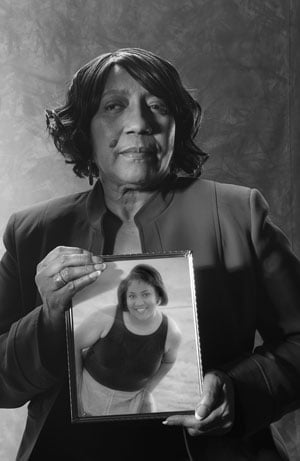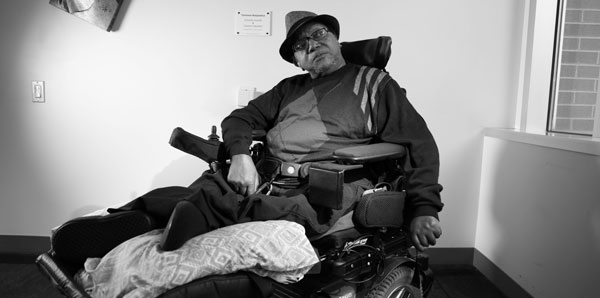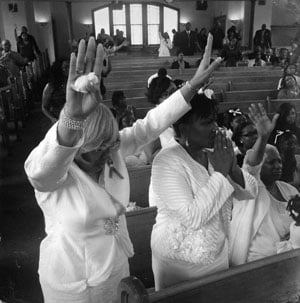Fines against unsafe nursing homes are considered a slap on the wrist

Mary Mims. Photograph by Don Levey.
Mims felt she could trust Alden Wentworth. After all, she once worked for its parent company, Alden Management Services, as an administrator overseeing various facilities, including the home where she placed her daughter.
“The mistake I made was gambling on the fact that these people knew me, and I trusted them to take care of my daughter,” Mims says.
Letasha Mims had been diagnosed with schizophrenia after she started showing symptoms in her 20s. Around that same time, Letasha stopped speaking. “I always felt that was a psychological thing, and whatever the trauma was, the health care system never got to the bottom of it.”
When assigned to outpatient care, Letasha frequently wandered away from home. Mims would have preferred to care for her there, but the need to work to support them both made that a practical impossibility. Finally, Mims decided that Letasha needed to be in a nursing home, where her condition could be monitored and Letasha would be safe. That proved problematic.
In the 11 years before her death in August 2014, Letasha Mims lived at six different nursing homes. Each move had been made necessary by Mims’ fear that her daughter’s safety was in jeopardy. As a registered nurse, Mims believed that at times her daughter was being overmedicated with sedatives and antipsychotic drugs; at others, Letasha had bouts with a highly contagious skin disease known as scabies. But Mims says she worried most about the potential for sexual assault because Letasha was placed in locked units, often with men diagnosed with mental illness and side effects of drug abuse. Many nursing homes often refuse to admit young women precisely because of the high risk of sexual assault. And in places that do, supervision is often scant.

Letasha Mims shortly before her death. Photograph Courtesy of Mary Mims.
In February 2014, Mims was visiting Letasha after work when she realized that her daughter was running a seriously high fever. “I bent down to kiss her, and the heat was just coming off her,” says Mims. When Mims asked that Letasha be properly hospitalized for what appeared to be a life-threatening fever, the staff balked. “I had to insist that Letasha be sent to the hospital for evaluation because her fever was 104, in spite of having had a couple of rounds of antibiotics,” Mims says.
Letasha never returned to Alden Wentworth and died six months later in hospice care. Her fever had subsided, but never left. Mims believes that her elevated temperatures were the result of a pressure sore that developed into osteomyelitis. “She had a sacrum wound. It got infected down to the bone. She never recovered from that wound. She finally broke down, and that was the end of it.”
It was not the end of it for Mims. She has filed a wrongful death lawsuit against Alden Wentworth. As a nurse and a former colleague, Mims says she had hoped for better treatment for her daughter. But Letasha’s last days at Alden Wentworth were spent in what Mims remembers as a cesspool of systemic negligence: days marked by urine-soaked linens, feces-laden toileting pads, aggravated bedsores, malnourishment and gangrene.
A Fine System
The lack of regulatory response was even more galling to Mims. Illinois state regulators investigated the circumstances of Letasha’s death and found no wrongdoing at Alden Wentworth. As in many states, nursing home regulation in Illinois has become what some describe as toothless and sporadic. And a brief history of state intervention at Alden Wentworth before and after Letasha’s death suggests a curiously comfortable relationship between regulators and the regulated.
In 2010, the facility had been cited by the state for negligence involving the sexual assault of a female resident. Surveyors noted that the male accused in the incident had been allowed access to particularly vulnerable female residents—those with Alzheimer’s and dementia—before he had been evaluated for such a potential risk. Likewise, in 2010, a 41-year-old patient with a history of substance abuse had died of an overdose from a Fentanyl patch. Three weeks before his death the Alden Wentworth staff had dispensed to him both the Fentanyl patch and Vicodin, despite a hospital discharge instructing that he not receive narcotics. And in 2008, the home was cited for ignoring foot blisters on a 58-year-old paraplegic with Type 2 diabetes. By going untreated, the blisters became wounds deep enough to make visible the muscles in her feet.
Even had there been a finding in Letasha’s case, the actual outcome of the penalties associated with those earlier violations at Alden Wentworth suggests that any regulatory response would have been minimal. For the overdose death the facility was assessed $5,000. For failure to treat the diabetic, a $10,000 fine was reduced to $2,000. And for the negligence that led to the sexual assault, Alden Wentworth was assessed no fine at all.
This kind of significant fine reduction is a standard practice within the tangle of interdependent state and federal agencies that oversee nursing home regulation. In fact, it’s a regulatory system structured around administrative fines—fines that are reduced so routinely that they have become widely considered a cost of doing business rather than an incentive to provide quality care.
From 2014 through March 2016, the nation’s nursing homes had been fined $121 million for deficiencies, according to federal regulators. In addition, nursing homes that fail to correct deficiencies are at risk of losing Medicare or Medicaid payments for new residents until the corrections occur.
But on closer look, the fines are discounted, often automatically, as a matter of policy. Under federal law, nursing homes can waive their right to appeal fines and get an automatic 35 percent reduction. Between 2008 and 2012, Alden Wentworth was fined a total of $75,000, fines later reduced to $27,500. Between 2005 and 2014, the 27 homes in its parent company, Alden Management Services, were fined $976,675, later reduced by 65 percent to $342,245.
A similar pattern exists statewide. The ABA Journal analyzed Illinois deficiency reports, which show that the state assessed $7.17 million in fines for 934 deficiency findings from 2010 to 2014—the most recent full year for which data was available. Those fines were ultimately reduced by an average of 42 percent to $4.17 million.
In Illinois, nursing homes can challenge deficiency findings through informal dispute resolution or administrative evidence hearings. Most deficiency disputes settle before reaching an administrative hearing, according to the Illinois Department of Public Health, and it seems that the nursing home operators take full advantage.
For instance, 43 percent of the fines were reduced automatically when the homes cited waived their right to appeal the findings. Another 39 percent of the homes had fines reduced after administrative hearings. In other words, 82 percent of fines levied by Illinois regulators were reduced as a matter of policy.
Even when residents die in nursing homes, fines related to those cases are frequently and significantly reduced. Between 2004 and 2013, the Illinois Department of Public Health examined complaints related to 114 nursing home deaths. The state assessed a total of $3.6 million in fines from those cases. Yet that number was reduced to $1.6 million for final assessed fines. The average final fine amount for a death was just over $14,000.
To complicate matters, nursing homes also can appeal findings in federal administrative evidence hearings. Those rulings can be appealed, as well, to the departmental appeals board. And if a party disputes a DAB finding, it can be appealed to the federal court system. Thus, there is every incentive to delay, appeal or even ignore regulatory action.
“It can take five years or more to exhaust all of these steps, and at each step the fine might be reduced by settlement or an administrative law judge court decision,” says Joseph Bianculli, an Arlington, Virginia, lawyer who defends nursing homes in federal hearings.
Brian Lee, executive director of the advocacy group Families for Better Care, puts it more bluntly: “It’s more profitable for nursing homes to roll the dice with the potential for enforcement, or litigation, than to hire more staff, especially with some penalties being little more than slaps on the wrist.”
Taking care of people who need skilled nursing is a difficult job. Patients arrive with ailments such as dementia, immobility, blindness and respiratory problems, and are often in advanced stages of other diseases. Under these conditions, faltering health could give a false impression of substandard care.
“If you have problems like diabetes—and you’re wheelchair-bound or bed-bound and you’re incontinent—it’s not a surprise to see that pressure sores develop,” says James E. Phelan, a Chicago lawyer who has defended various nursing homes, including Alden, in personal injury lawsuits.
Risk and Reward
In Illinois, nursing homes receive $148.92 per day on average for each Medicaid resident. Home operators argue that amount makes it difficult to provide quality care and make enough money to stay in business. A plethora of laws at the state and federal levels make compliance a complicated and expensive process, and excessive fines would be counterproductive.
“If you look at its legislative history, the sole purpose of [fines] imposed by the government was to provide an incentive for providers to come into compliance. It’s remedial, not punitive,” says Alan C. Horowitz, a former federal regulator who now represents skilled care facilities on regulatory issues for Atlanta’s Arnall Golden Gregory.
“This isn’t about the nursing home; it’s about the residents. And if the nursing home is driven out of business or if funds used to pay civil money penalties are diverted from being used for ... staff and/or equipment, the fines are not productive,” he says.
But nursing homes are profitable—a significant segment of the senior housing market. Welltower, a real estate investment trust specializing in health care real estate, reported $884 million in net income last year and holds $29 billion in assets. Alden Management Services, a far more modest system owned by Floyd Schlossberg, reported $18.6 million net income in 2014.
Michael Grice believes the sources of profit are personnel-driven. A quadriplegic with cerebral palsy, Grice spent two years in a Chicago nursing home he describes as chronically understaffed. Personnel often worked double shifts and call lights routinely went unanswered. Grice says he had to assert himself. “I was not going to tolerate not being changed and not being fed.” Grice, who now lives on his own, had to insist upon being turned every two hours to avoid pressure sores. But when he was lifted, he says, he was sometimes dropped—once resulting in a broken hip.
The home he was in is Southpoint Nursing and Rehabilitation Center on the Far Southwest Side, whose owners of record are Michael Blisko and Moishe Gubin. Between 2007 and 2014, nursing homes owned by the pair were assessed $169,500 in fines on 15 separate deficiency reports. Those fines were reduced more than half, to $75,565. Blisko and Gubin’s homes reported net income of $5.2 million in the 2014 fiscal year.

Michael Grice spent years in a Chicago nursing home he says was chronically understaffed. Photograph by Wayne Slezak.
Fines, even in such a profitable environment, do not need to be punitive to be effective, says David Hoffman, a former federal prosecutor who handled health care fraud and abuse cases. Based in Philadelphia, he now does reg-ulatory compliance consulting with nursing homes. He says that if a client doesn’t want to comply with regulation, he will fire them.
“It doesn’t have to be about banging providers over the head with fines, but there are some providers who need to be clubbed over the head.”
Regulation Matters
The enforcement of nursing home regulations is managed by the Centers for Medicare & Medicaid Services, an agency within the U.S. Department of Health and Human Services. But the CMS relies on state health departments to investigate facility complaints and conduct annual surveys, and then share their findings with the federal government. When inspectors find problems, they list them as “statements of deficiencies,” which come with fines for serious infractions.
Deficiencies can include mistreatment of residents; failure to assist residents who need help with eating, drinking, grooming and personal hygiene; and failure to provide proper care to treat or prevent bedsores. Nursing homes must submit written plans of correction to the state for deficiencies cited, but these are not considered admissions of guilt.
Nursing homes can challenge findings through state administrative evidence hearings or informal dispute resolution. Challenging a fine may be a strategic decision, says Bianculli, the former regulator. He once had a client who appealed a $400 fine, believing that a successful appeal would stop future civil litigation.
“You have to decide in advance what part appealing the fine is going to play in terms of compliance, regulation and your business plan,” Bianculli says. “If you’re going to use the regulatory process to keep the surveyors from running amok or raise issues that need to be addressed, it’s good.”
The CMS makes the final determination for fines related to patients over 65 whose short-term stays are paid by Medicare. But states are responsible for determining fines related to patients whose stays are paid by Medicaid, the joint federal and state program that covers low-income individuals and pays for indefinite nursing home stays.
Of the numerous changes to nursing home regulation set out under the Affordable Care Act of 2010, only a few involved actual enforcement. For instance, proposed new rules would allow binding pre-dispute arbitration agreements between facilities and residents, limiting litigation as an option for residents, a change opposed by the American Bar Association.
In the ACA, nursing home regulation is focused on transparency issues—mainly ownership and management records—hoping to help consumers make informed decisions about their nursing home choices. A pre-existing ratings system, for instance, assigns ratings based on qualitative issues such as health inspections and staff, as well as overall quality of care. But some are skeptical.
“I think that policymakers and politicians love the idea of public reporting of health care quality, because it’s intuitively appealing,” says Tamara Konetzka, an economist and University of Chicago professor who sits on a CMS advisory board. “If you tell consumers which nursing homes are high-quality, they will make their own decisions. Of course it’s much more complicated than that.”
Staff, and issues with staff, are key to a wide range of complaints and deficiency reports. If nursing homes used some of their net earnings to hire more staff, goes the logic, they’d have fewer regulatory deficiencies.
“Illinois is not unlike any other state that has problems, and the reason they have the problems is because they continue to have low staffing at nursing homes,” says Lee of Families for Better Care. “It always comes back to staffing. Whatever the issue is, the underlying problem always goes back to turning people and answering call lights.”
COST VS. CARE
Viewed bluntly, as some do, a regulatory system based almost solely on fines becomes more negotiation than administration, a system that pits cost against patient care. Even the optics of an investigation suggest as much, says Grice, who complained to no avail when his hip was broken after nursing home staff dropped him.
“When the Department of Public Health inspector comes to the nursing home, they may talk to the resident, and they may talk to some staff. Then they talk to the administrator and owner behind closed doors, and a resident never really sees what the end result is.”
Like Grice, Mims has little confidence in the system. “Sadly, the fines are not a deterrent to providing substandard care,” she says. “I absolutely believe that the large [nursing home] chain companies have attorneys that do nothing but fight these types of cases from leading to significant penalties or consequences.”
During the time Letasha was at Alden Wentworth, her mother spent most evenings with her. After a time Mims found herself feeding Letasha, who could no longer feed herself. Before leaving she’d give Letasha a sponge bath and dry her off. These were things the staff should have been doing, but did not.

“I will never forget my daughter’s suffering and what she experienced at the end of her life,” Mims says. Photograph Courtesy of Mary Mims.
On weekends Mims brought home Letasha’s clothes to wash. On occasion, she says, her daughter’s clothes would disappear, and she might see other residents wearing the items. But she noticed that the clothing was frequently soaked with urine and feces. And when she complained about it, Alden Wentworth’s director of nursing ignored her concerns.
“Then I did a show and tell,” says Mims, who emptied a bag of Letasha’s dirty clothes in the director’s office. “A pee smell went all over her room, and I said ‘This is what I have to deal with every single week.’ ”
The woman told Mims that she’d handle the problem. She did, Mims says, and for a few weeks her daughter had clean clothes. “Then it went back to what it was.”
One day while picking Letasha’s dirty clothes out of the hamper, Mims noticed rodent feces at the bottom of it mixed up with the bed linens. She again went to the director of nursing and began lining the clothes hamper with garbage bags, thinking that would keep the rodents at bay. Then came the bedsores. Mims was usually the first person to notice them; because of her nursing experience, she knew that wounds would develop if her daughter was repositioned too infrequently.
Under Illinois law, residents who need skilled care are required to get 3.8 hours of nursing and personal care daily. Mims saw no evidence that Letasha was getting even the minimum. She thought a show of generosity might influence the staff to give her daughter better care. She brought them dinner on Thanksgiving, bought lotions and gels for them at Christmas and handed out boxes of candy on Valentine’s Day.
“That didn’t change a thing,” Mims says.
Calling attention to Letasha’s care problems didn’t help either. She frequently complained about Letasha being overmedicated, her bedsores and weight, which according to Mims dropped from 160 pounds to 107 during the Alden Wentworth stay. And as Letasha withered, Mims says, the staff seemed almost defiant.
“They knew I knew what to expect. They knew I knew the system, and they knew I knew the regulation like the back of my hand,” Mims says. “Here’s the problem that I have: That did not bother them. How do you neglect the resident whose mother knows all the regulation? Either you’re cocky, or you just don’t give a hoot.”
Mims began taking pictures of the wound that developed from Letasha’s unattended bedsore. The photos begin with what looks like a scrape, then progress to a gaping wound that exposes her sacrum. When she developed an infection, the staff tried unsuccessfully to treat it with intravenous antibiotics.
When the staff balked at removing Letasha to a hospital with a 104-degree fever, Mims decided it was a matter of money. “It’s an unwritten rule that you don’t send out residents. If the staff doctor gives the residents antibiotics and fluids, then the nursing home still gets to keep the Medicaid payments.” Mims insisted Letasha be moved. She died six months later in hospice care.
After Letasha’s death, Mims sent her photos to Illinois regulators along with her complaints. She was disappointed, but not surprised, when the department found no violations. “I think they had no intention of having any findings. There’s no way you could look at those pictures and not see that there was a problem.”
In 2014, Mims filed a wrongful death suit in Cook County against Alden Wentworth, one of 11 lawsuits filed against the facility in the past two years (see “Lawsuits Fail to Bring Improvements to Nursing Homes”). Omar J. Fayez, a Chicago lawyer who represents Alden Wentworth in the Mims suit, says his client has a policy of not discussing specifics in ongoing litigation. He told the Journal that his client “vehemently denies” any allegations of wrongdoing by Mims and her attorneys.
Mims has since left the nursing home industry, where she worked for 10 years. She now manages quality control for a program that provides health services to Medicaid recipients.
“I have no confidence with the regulatory system whatsoever. That’s the reason I’m not working in long-term care anymore. I knew I was fighting a losing battle,” Mims says. “I will never forget my daughter’s suffering and what she experienced at the end of her life. It is what keeps me driven to change this horrible system called long-term care.”
Jeff Kelly Lowenstein contributed research and editing to this story. He’s an investigative journalist who has worked on stories about nursing homes since 2004, and his previous coverage helped spark state and federal reform; in 2015 his work earned recognition from the National Press Club.
This article originally appeared in the August 2016 issue of the ABA Journal with this headline: “The Human Cost of Doing Business: Fines against nursing homes are routinely reduced and considered a slap on the wrist rather than incentives to provide better care.”
Sidebar
METHODOLOGY
The ABA Journal filed a Freedom of Information Act request with the Illinois Department of Public Health to receive data on nursing home fines from 2010 to 2014, the most recent full year for which data was available. The request asked for, and the agency provided, information about the amounts and dates of the initial and final fines, as well as whether the facility decided to appeal the fine. The Journal used that information to calculate the percentage of fines that were appealed, the average time the IDPH took to arrive at a final fine and the amount by which the original fines were reduced. For the analysis involving fines and deaths, the Journal looked at quarterly reports posted between 2004 and 2013 on the IDPH website for all incidents where any facility in the state was fined at least $20,000. The Journal used the docket or incident number from the FOIA request and the website to confirm that they were the same.



